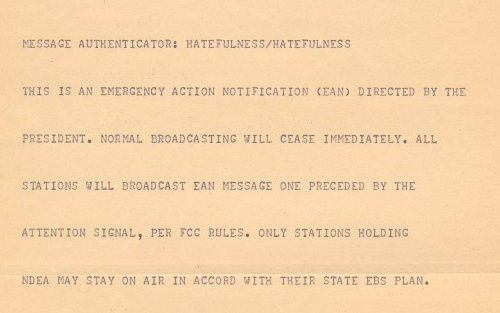If you were in Fort Wayne, Indiana on February 20, 1971, you might have felt like the end of the world was coming.
All thanks to a mix-up from the Emergency Broadcast System.
Anyone who’s ever watched broadcast TV or listened to the radio knows that tone that gets used when they want to warn us about severe weather?
That system was originally set up during the Cold War, and it wasn’t originally to warn us about weather emergencies.
The original system worked a little differently than it does now.
The government sent radio and TV stations special booklets each month with a series of code words.
Each day the Emergency Broadcast System would send out a message to the stations on teletypes and wire machines.
Everything was totally copacetic and they would go about their usual business, unless the government sent out a message that included that preselected code word.
On February 20, 1971, the authentication code was “hatefulness,” which was kind of a creepy word choice, given what it was for.
And that was the word at the top of the morning EBS message.
That meant broadcasters were supposed to stop their normal operations and go into a kind of standby mode until authorities sent further instructions, like “wait for a message from the president,” or “proceed to your local civil defense shelter,” or “it’s the end of the world as we know it and I feel fine.”
A lot of stations didn’t do that.
Some didn’t really know how to handle an actual emergency, and others just correctly guessed that the emergency code had been sent out by mistake.
But some of us are rule followers, like the dutiful on-air staff at WOWO-AM in Fort Wayne, Indiana.
Host Bob Sievers took to the airwaves to warn Americans that the government had declared a national emergency and it was unlikely that anyone in the greater Fort Wayne area would be alive to hear the end of the Partridge Family’s hit “Doesn’t Somebody Want to Be Wanted?”
Freaked out Fort Wayne radio listeners started flooding the station with calls to find out what the heck was going on.
But Sievers didn’t know!
He explained that the government had triggered its emergency protocol but nobody had said why.
“Please, please do not call us to ask what is the matter,” he said. “We are endeavoring to find out ourselves.”
The civil defense people quickly sent out another message canceling the alert with the authentication code “impish,” and they later retooled the EBS alert process entirely.
They did away with the code words and, probably, the dude who sent out the false alarm.
Sievers was able to let the WOWO audience know that Air Force staff at Cheyenne Mountain in Colorado had put the wrong message out on the wire.
And Fort Wayne is still with us today.
So the Emergency Broadcast System was originally designed to turn the whole set of US broadcast stations into one big network in case the president wanted to speak to everybody at once during a national emergency.
But as the government started wising up to the power of mass media, they realized even the Commander in Chief might not be the most reassuring voice during a nuclear crisis.
Who was, you ask?
Apparently entertainment impresario Arthur Godfrey!
The feds had Godfrey record a message along the lines of “yes, nuclear war has broken out, but try not to panic.”
Researchers have confirmed there was such a message, though they haven’t yet found a copy.
Still, it’s good to know that midnight on the Doomsday Clock just means it’s Arthur Godfrey Time.
The World Is About to End – Or Maybe Just Fort Wayne: The False Alarm of 1971 (BradyCarlson.com)

